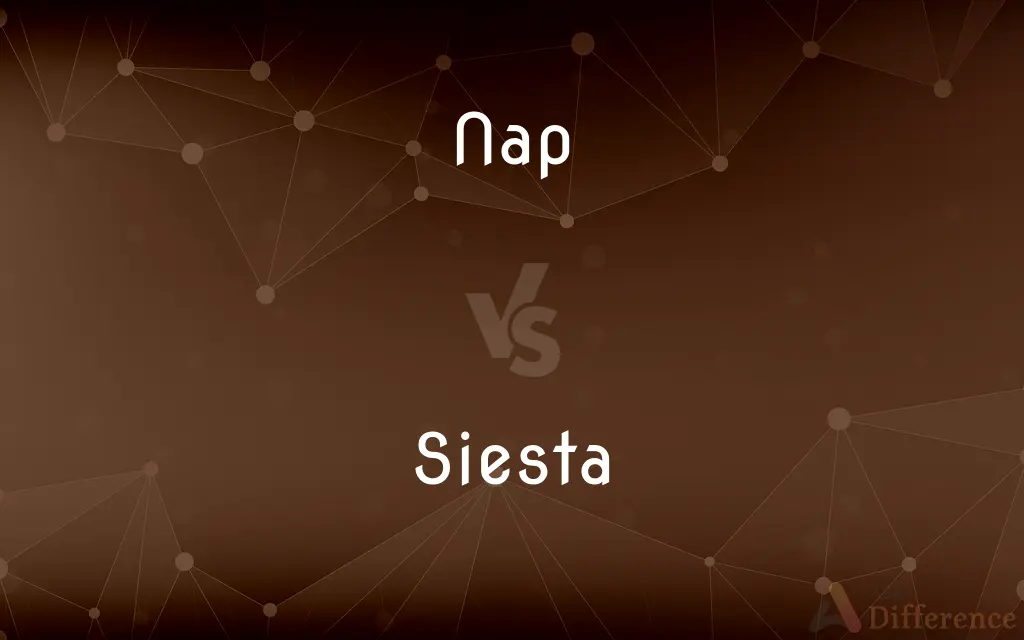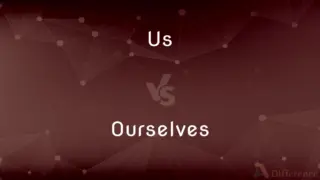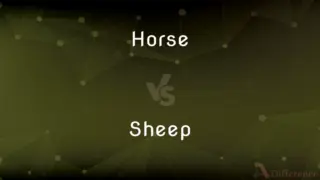Nap vs. Siesta — What's the Difference?
By Urooj Arif & Fiza Rafique — Updated on March 28, 2024
A nap is a short sleep usually taken during the day to boost energy, while siesta is a traditional rest or nap after lunch, particularly in hot climates or cultures like Spain's.

Difference Between Nap and Siesta
Table of Contents
ADVERTISEMENT
Key Differences
A nap refers to a brief period of sleep, typically taken during the day, to refresh or recharge one’s energy levels. It is a flexible concept, with no specific time or duration, and is practiced worldwide. On the other hand, a siesta is a culturally ingrained rest period that occurs after the midday meal, especially in hot climates and primarily in Spanish-speaking countries. It can last from 20 minutes to a few hours, often aiming to avoid the hottest part of the day.
Napping can be a spontaneous or planned activity to combat fatigue or simply enjoy a moment of relaxation. It is commonly seen as part of a healthy lifestyle, aiding in improving mood, alertness, and performance. Siesta, however, is more of a traditional practice, deeply embedded in the lifestyle and work schedules in regions where it is observed, with businesses and shops closing during siesta hours to allow employees to rest.
The benefits of a nap include improved cognitive function, emotional regulation, and physical health. Similarly, siestas offer these benefits but are also specifically tailored to align with natural circadian rhythms and the environmental demands of hotter climates, potentially contributing to greater overall well-being.
While napping is widely accepted and can be adapted to fit any lifestyle, the siesta is tied to specific cultural norms and expectations, reflecting a slower-paced lifestyle that values rest as part of daily routine. However, globalization and modern work demands have led to a decline in traditional siesta practices in some areas, though the concept remains popular.
Both napping and taking a siesta highlight the importance of rest in human health and productivity. Despite their differences in cultural roots and implementation, they serve the common purpose of revitalizing the body and mind.
ADVERTISEMENT
Comparison Chart
Definition
A short sleep taken at any time of day for refreshment.
A rest or nap taken after the midday meal, especially in hot climates.
Origin
Global practice without specific cultural origins.
Traditionally observed in Spain and some Latin American countries.
Timing
Flexible, can be taken anytime during the day.
Typically after lunch, aligning with the hottest part of the day.
Duration
Usually short, ranging from 10 to 30 minutes.
Can vary widely, often between 20 minutes and 2 hours.
Purpose
To boost energy, improve mood, and enhance performance.
To avoid the hottest part of the day, rest, and improve well-being.
Cultural Significance
Widely accepted and adaptable to individual needs.
Deeply embedded in the lifestyle and traditions of certain cultures.
Adaptation to Modern Life
Easily integrated into modern lifestyles.
Traditional practice affected by globalization and modern work schedules.
Compare with Definitions
Nap
A short period of sleep taken during the day.
She took a 20-minute nap to rejuvenate.
Siesta
A rest or nap following the midday meal, part of certain cultures.
During the siesta, the streets of the small town were quiet.
Nap
Intended to quickly refresh or recharge energy levels.
A quick nap can significantly improve alertness.
Siesta
Traditionally lasts from after lunch until mid-afternoon.
The family enjoyed a leisurely siesta before returning to work.
Nap
Can be taken spontaneously or as part of a daily routine.
He has a daily nap after work to relax.
Siesta
Often involves closing businesses during siesta hours.
Shops in the town close for siesta and reopen later in the afternoon.
Nap
Beneficial for cognitive and physical health.
Studies show napping can boost memory and learning.
Siesta
Reflects a lifestyle that values rest as essential.
The siesta is an important part of their daily routine for well-being.
Nap
Adaptable to any lifestyle or work schedule.
Many workers use their break time for a brief nap.
Siesta
A practice especially common in hot climates.
The siesta allows people to avoid the midday heat.
Nap
A nap is a short period of sleep, typically taken during daytime hours as an adjunct to the usual nocturnal sleep period. Naps are most often taken as a response to drowsiness during waking hours.
Siesta
A siesta (from Spanish, pronounced [ˈsjesta] and meaning "nap") is a short nap taken in the early afternoon, often after the midday meal. Such a period of sleep is a common tradition in some countries, particularly those where the weather is warm.
Nap
A brief sleep, often during the day.
Siesta
An afternoon rest or nap, especially one taken during the hottest hours of the day in a hot climate
Everyone had a siesta for a few hours
Nap
A soft or fuzzy surface on fabric or leather.
Siesta
A rest or nap, especially one taken after the midday meal.
Nap
A trick-taking card game in which the players are each dealt five cards and everyone bids the number of tricks they intend to take, with the highest bidder deciding the trump.
Siesta
A nap, especially an afternoon one taken after lunch in some cultures.
Nap
The first bid of five tricks in this game, the maximum number in a hand. Also called napoleon.
Siesta
(intransitive) to take a siesta; to nap.
Nap
See napoleon1.
Siesta
A short sleep taken about the middle of the day, or after dinner; a midday nap.
Nap
To sleep for a brief period, often during the day; doze.
Siesta
A nap in the early afternoon (especially in hot countries)
Nap
To be unaware of imminent danger or trouble; be off guard
The civil unrest caught the police napping.
Nap
To form or raise a soft or fuzzy surface on (fabric or leather).
Nap
To pour or put a sauce or gravy over (a cooked dish) in a thin, even layer
"a stuffed veal chop napped with an elegant Port sauce" (Jay Jacobs).
Nap
A short period of sleep, especially one during the day.
Nap
A soft or fuzzy surface, generally on fabric or leather.
Nap
The common direction, on some kinds of fabric, of the hairs making up the pile.
If the fabric has a nap, make sure all pieces are cut with the nap going the same direction.
Nap
(British) A type of bet in British horse racing, based on the experts' best tips.
Nap
A card game in which players take tricks; properly Napoleon.
Nap
A bid to take five tricks in the card game Napoleon.
Nap
A cup, bowl.
Nap
To have a nap; to sleep for a short period of time, especially during the day.
Nap
(figuratively) To be off one's guard.
The regulators were caught napping by the financial collapse.
Nap
To form or raise a soft or fuzzy surface on (fabric or leather).
Nap
(obsolete) To grab; to nab.
Nap
(cooking) To cover (something) with a sauce. usually in the passive
Nap
To have a short sleep; to be drowsy; to doze.
Nap
To be in a careless, secure state; to be unprepared; as, to be caught napping.
I took thee napping, unprepared.
Nap
To raise, or put, a nap on.
Nap
A short sleep; a doze; a siesta.
Nap
Woolly or villous surface of felt, cloth, plants, etc.; an external covering of down, of short fine hairs or fibers forming part of the substance of anything, and lying smoothly in one direction; the pile; as, the nap of cotton flannel or of broadcloth.
Nap
The loops which are cut to make the pile, in velvet.
Nap
Same as Napoleon, 1, below.
Nap
A period of time spent sleeping;
He felt better after a little sleep
There wasn't time for a nap
Nap
A soft or fuzzy surface texture
Nap
The yarn (as in a rug or velvet or corduroy) that stands up from the weave;
For uniform color and texture tailors cut velvet with the pile running the same direction
Nap
A short sleep (usually not in bed)
Nap
A card game similar to whist; usually played for stakes
Nap
Take a siesta;
She naps everyday after lunch for an hour
Common Curiosities
How long should a nap last?
A nap should last between 10 to 30 minutes to prevent grogginess and maximize rejuvenation.
Is siesta still widely practiced?
While still observed in many communities, traditional siesta practices have diminished in some areas due to modern work schedules and globalization.
Can a nap replace lost night sleep?
While naps can temporarily improve alertness and performance, they cannot fully replace the benefits of a full night’s sleep.
What is the purpose of a siesta?
The siesta serves to avoid the hottest part of the day, allowing for rest and improved well-being in accordance with natural circadian rhythms and cultural practices.
Why do people take naps?
People take naps to quickly rejuvenate energy, improve mood, and enhance cognitive function.
What are the health benefits of a siesta?
Similar to naps, siestas can improve mood, cognitive function, and overall physical health, while also aligning with natural body rhythms.
Can anyone adopt the practice of siesta?
Yes, anyone can adopt the practice of siesta, though it may require adjustments in daily schedule to accommodate the rest period.
How do modern lifestyles affect napping and siesta habits?
Modern lifestyles, especially work demands and the 24/7 economy, have made it challenging for some to find time for naps or traditional siesta practices, though there's a growing recognition of their benefits for well-being and productivity.
How do cultural attitudes towards napping and siesta differ?
Cultural attitudes toward napping are generally flexible, seeing it as a healthful practice, while siestas are more culturally ingrained, reflecting a specific lifestyle that values rest.
What impact does a siesta have on work productivity?
A siesta can improve work productivity by allowing individuals to rest and recharge, leading to increased alertness and performance in the latter part of the day.
Share Your Discovery

Previous Comparison
Us vs. Ourselves
Next Comparison
Horse vs. SheepAuthor Spotlight
Written by
Urooj ArifUrooj is a skilled content writer at Ask Difference, known for her exceptional ability to simplify complex topics into engaging and informative content. With a passion for research and a flair for clear, concise writing, she consistently delivers articles that resonate with our diverse audience.
Co-written by
Fiza RafiqueFiza Rafique is a skilled content writer at AskDifference.com, where she meticulously refines and enhances written pieces. Drawing from her vast editorial expertise, Fiza ensures clarity, accuracy, and precision in every article. Passionate about language, she continually seeks to elevate the quality of content for readers worldwide.
















































